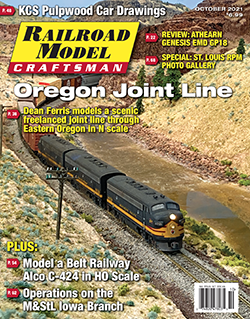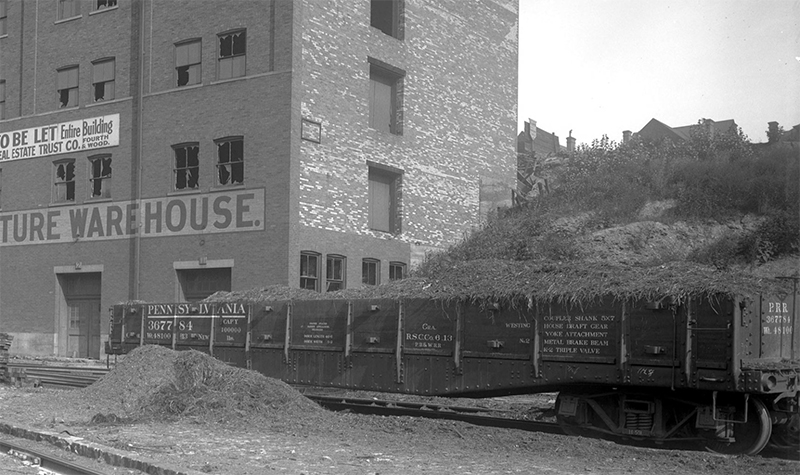 Most of us know about train orders, which control the movement of trains. But train odors are a bit different. They’re about getting the olfactory essence of the real thing into our model railroads.
Most of us know about train orders, which control the movement of trains. But train odors are a bit different. They’re about getting the olfactory essence of the real thing into our model railroads.
As kids, we remember seeing gondolas heaped high with what appeared to be straw, often emitting a slight fog in cool weather as the train rolled by. Later we discovered it was not straw at all, but rather manure heading for the mushroom farms in Pennsylvania and elsewhere.
Recently, a member of our operating group emailed a photo of such a gondola being loaded with manure and suggested it might make a perfect load for another group member’s railroad. Often someone in our group will share a significant nugget about railroads, or a photo that will enhance the collective knowledge. Sometimes those nuggets spark conversations but the photo of the gondola set off an avalanche of emails among all of us.
One member noted that western Washington was a great place to grow mushrooms and that perhaps the Tacoma Belt Railroad (Scott’s layout) could start moving manure. Maybe it could even be sourced from the Midwest, giving him an excuse to have some Detroit, Toledo & Ironton gons (although that would be quite the distance traveled for such a load).
Jim, a former Penn Central and Conrail railroader, recalled that he used to see a train called CP-4 that often had gons of Kentucky horse manure bound for Pennsylvania. Speaking of another stinking train, Steve recalled seeing stock trains on the Baltimore & Ohio, Conrail and Union Pacific. All of them equally stunk. “Heaven help you if you were on the downwind side of the cars when they went by at 60 miles per hour,” he wrote. That reminded Jim of the carloads of offal (pronounced “awful”) he had seen over the years, which consisted of the leftovers from the slaughtering process. The offal was sent to rendering plants to make greases and oils. Another member of the group and retired railroader, Dick, recalled handling those “awful” loads on the Chesapeake & Ohio.
Eventually, our conversation went on to include other train odors. Dave recalled the smell of creosote ties on a hot summer day when he used to walk the tracks as a kid. Memories of those days were brought back recently, he said, when he found an unopened package of scale ties from 60 years ago that had been treated with creosote, just like the real thing. That was confirmed when he opened the package and the strong creosote smell emerged. “I have fond memories as a kid of walking the tracks on hot summer days with the odor of creosote wafting through the air,” he wrote. “But I can’t imagine my layout reeking of creosote all the time.”
While sound and lights have all become standard-issue on models in recent years, smell is something that’s still lacking. One member of our group wrote that he would love to model a dirty old steam-era roundhouse with the smell of coal smoke, valve oil and steam wafting through the air. Another friend said he once considered putting pine room fresheners under a layout so the smell of a pine forest would fill the end.
That was just a sampling of our discussion about adding smells to model railroads. But the reality is more difficult. While most of these messages were written with tongue in cheek, the problem is strength and containment. It’s pretty easy to reduce a locomotive or car or building to 1/87th or 1/48th its prototype size. Even sounds can be easily reduced in volume. But how do you scale down a smell? We wonder how to reduce the smell of horse manure or coal smoke or pine trees to a fraction of their true smell. Then there’s the problem of containing the smell to a specific area, or a specific car, on the layout. We get into this to some extent with sounds. DCC is wonderful in its ability to generate a multitude of sounds. But limiting them to a specific spot on the layout is close to impossible. Odors are worse. They spread quickly and, worse, linger indefinitely. You can’t turn them off after a few seconds. And they don’t dissipate easily, as odors do outdoors. Anyone who’s been in a room or basement at a layout where the model steam locomotives are spewing smoke knows how overwhelming that can be. We had to retreat coughing and with tears in our eyes after a few minutes. Odors would be worse.
While we can have fun imagining a model railroad where manure smells like, well, you know… and perhaps enjoy the happy nostalgia of the smell of bituminous coal smoke and creosote and valve oil, adding those to our model worlds is probably best left to the imagination.
—Scott Williamson and David Richter


